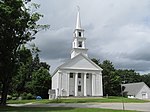Templeton Developmental Center
1899 establishments in MassachusettsHistoric districts in Worcester County, MassachusettsHistoric districts on the National Register of Historic Places in MassachusettsHospital buildings completed in 1899Hospitals in Worcester County, Massachusetts ... and 5 more
NRHP infobox with nocatNational Register of Historic Places in Worcester County, MassachusettsPsychiatric hospitals in MassachusettsTempleton, MassachusettsUse mdy dates from August 2023

The Templeton Developmental Center was a state-run facility for mentally disabled people located in Templeton, in the U.S. state of Massachusetts. Founded as the Templeton Farm Colony in 1899 through the efforts of Walter E. Fernald, superintendent of what is now called the Fernald School in Waltham, Massachusetts, it was considered an innovative and progressive facility for managing the state's developmentally disabled population at the time. The large facility was closed in 2015, with some intermediate care facilities remaining open on the campus. The property and some of the buildings were listed on the National Register of Historic Places in 1994.
Excerpt from the Wikipedia article Templeton Developmental Center (License: CC BY-SA 3.0, Authors, Images).Templeton Developmental Center
Freight Shed Road,
Geographical coordinates (GPS) Address Nearby Places Show on map
Geographical coordinates (GPS)
| Latitude | Longitude |
|---|---|
| N 42.599722222222 ° | E -72.118888888889 ° |
Address
Freight Shed Road
Freight Shed Road
01436
Massachusetts, United States
Open on Google Maps










